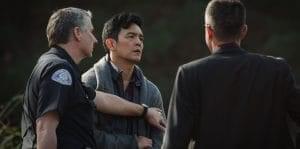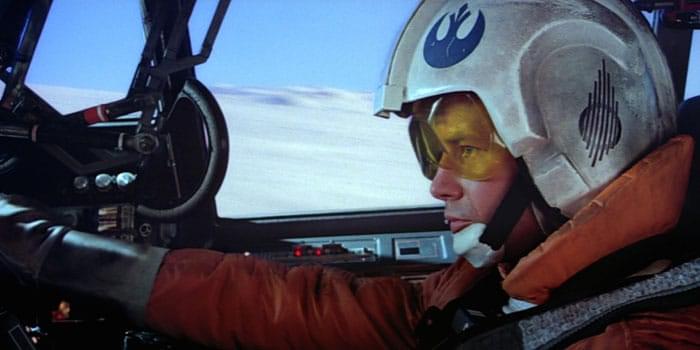
After David Kim (John Cho)’s 16-year-old daughter goes missing, a local investigation is opened and a detective is assigned to the case. But 37 hours later and without a single lead, David decides to search the one place no one has looked yet, where all secrets are kept today: his daughter’s laptop. In a hyper-modern thriller told via the technology devices we use every day to communicate, David must trace his daughter’s digital footprints before she disappears forever.
Film Threat spoke with Searching’s Director Aneesh Chaganty and his writing partner, Sev Ohanian at the 2018 Los Angeles Asian Pacific Film Festival. We talked about how the project came together and how Aneesh almost blew the chance of a lifetime.
What is the basic story behind Searching?
Aneesh Chaganty: Searching is basically a very classic thriller told in a very unconventional way. The classic thriller part is that it’s about a dad played by John Cho, who goes looking for his daughter when she goes missing. The unconventional part about it is that the whole movie is told on the devices that we use every day to communicate: smartphones, laptops, tablets. Anything that is electronic is the medium that we tell the story on.
All right. He’s searching for his daughter. Basically, authorities are unable to find her, so he’s using the social media basically to find her?
Aneesh Chaganty: Sort of like simultaneous to a ground investigation that’s being led by a detective played by Debra Messing. He is also trying to help pick up on clues and aid in that investigation by looking through Margot, who’s his daughter’s digital footprints via her computer and all of her, the path that she left online.

Aneesh Chaganty, director and co-writer of Searching
“That project was a huge movie, and we learned a lot from writing it. That movie will never get made…”
What was the seed of the idea? Where did it start and then how did it bloom to what you have today?
Sev Ohanian: The seed of the idea. Aneesh and I have been writing partners for a couple of years. We both met at USC film school. He was always a student that was the super creative one. He had great ideas and more than anything I always was drawn to how much of a hustler he was. I graduated from USC, and then Aneesh reached out to me…I had made a movie called Fruitvale Station where I was a co-producer. We went to Sundance and had a good experience.
Aneesh Chaganty: I immediately wanted to work with this guy. He had come back from Fruitvale Station at Sundance with a huge win. Somehow I convinced him to be my writing partner, and together we started writing our first project together. That project was a huge movie, and we learned a lot from writing it. That movie will never get made, but since then, we’ve worked on a bunch of different things. Then we made a Google Glass commercial together. I worked for Google in New York City, which leads to a big opportunity for Sev.
Sev Ohanian: All of that led to one day me having a general meeting with a company called Bazelevs. They had produced a movie with Blumhouse called Unfriended that, at the time, had made a lot of money for them.
Aneesh Chaganty: Unfriended takes place on a computer screen.
Sev Ohanian: Exactly. Unfriended made this company feel like they wanted to explore more films that would be told in unusual, you know on devices that we use every day. In that meeting with me, they’re like, “Do you know anybody who would be a good filmmaker for a movie that would be unconventional like that?” Of course, I thought immediately of Aneesh, who at the time was still writing and directing commercials at Google. So, I brought Aneesh in to meet with all of us.
Aneesh Chaganty: Their initial idea was that they wanted to follow-up Unfriended, but they wanted to do it with a feature that was comprised of a bunch of different short films, as opposed to one big story. I thought that was way more exciting of a concept than a feature film. Then a couple months go by, and Sev and I end up texting each other for the idea of Searching as a short film, and we really liked it. It’s an eight-minute short on a three-page pitch package that we sent back to the production company. I happened to be back in LA later on for a Google photo shoot. They call us in to talk about it, and the first thing they say is, “We don’t want to make this as a short film anymore. We want to do this as a feature. Sev, you can produce it. Aneesh and Sev, you can write it. Aneesh, you can direct it. We’ll finance the whole thing. What do you guys say?” Immediately, I just yelled out “No.”

Sev Ohanian, co-writer of Searching
“…you can write it…you can direct it. We’ll finance the whole thing. What do you guys say?” Immediately, I just yelled out ‘No.'”
Sev Ohanian: Aneesh literally turns down probably about a million dollars to write and direct his first ever feature. I’m sitting next to him kicking him.
I know. When a production company says, “Hey we’ll give you money to make a movie.”
Sev Ohanian: Yeah. How do you say no to that?!?
Aneesh Chaganty: At the time, it felt like we would be taking an idea that we somehow found a way not to be a gimmick, which was an eight-minute idea, and stretching it back into a full-length gimmick. We’re essentially making a movie not because it deserved to exist, but rather because another film had made money before it existed. None of those reasons were appealing to me, let alone that being my first movie. I said “No.” Sev said, “We’ll be in touch.”
So you felt like because it was more or less someone else’s idea and to piggyback on a concept that had already been done, that you were kind of hesitant about it.
Aneesh Chaganty: Yeah, they wanted to make it a feature because Unfriended was a hit, not because Searching was meant to be a feature. We didn’t see what it could be in that moment and what it would be later on. So we said no. I always stand by that reasoning because it felt like the right thing to say. Ultimately it allowed us to come up with the way into the story that we eventually found. Right when we left the room, Sev and I kept talking about the enormity of that opportunity and how rare it was. Ultimately, we should pay respect to the opportunity by just talking through it. If we hit a wall, we hit a wall.
Then one day we texted each other that we both have ideas for opening scenes. We got on the phone, and we pitched each other the exact same opening scene idea that we just come up with by ourselves. It’s a very specific opening scene in the film. All of a sudden with that opening scene, it felt like we had found this perfect marriage of the way to tell the story. And the story itself felt like it was thrilling and emotional.
Sev Ohanian: Yeah, and it was gonna be character driven, and people would be invested in the characters the story’s about. I think because it’s a hyper-modern thriller taking place on devices that we use every day. This opening would achieve our goal, which was to make people forget what they’re watching and focus on the story.

“…we all live our lives on our screens. I think in those moments, we experience every emotion possible on a day-to-day basis…”
What did you do to make the device angle exciting and worthy of being a feature film?
Aneesh Chaganty: Yeah, that was a challenge. Every single stage of every single part of this movie and every single day and hour we worked on it. We were always trying to take this conceit of screens that we use every day, something that is very mundane to us, like the phones in front of us, the phones in front of you, this screen over there. There are screens all around us. They’re inherently not cinematic because of the mundanity of them. But our challenge from day one was how do we make that cinematic. From the writing stage to the editing stage to the production stage, back to the editing stage, we were always trying to elevate this concept and use as much cinematic technique as we could to bring a level of popcorn-movie-going entertainment to a concept that honestly never felt like it could get that.
We thought if we could execute that, it could be one hell of a watch.
Sev Ohanian: In all honesty, we all live our lives on our screens. I think in those moments, we experience every emotion possible on a day-to-day basis, whether it’s happiness or love or laughter or sadness or tragedy. There’s no reason why Searching could not have shown all those emotions by taking advantage of the fact that we all live our lives on screens.
That’s one thing about these devices are people finding different ways to express feelings and emotions above just the text and the words they say.
Sev Ohanian: Yeah.
Would it be fair to say that because of the limited nature of the devices and the way you shot it, that your budget was really small? Were there more challenges, or easier challenges?
Sev Ohanian: Man, I think, you know it’s an independent film. I think when you see the movie, you probably couldn’t tell because I think we have such a strong team with us. Everyone from our producing partner, Natalie Qasagian, all the way down to our PAs. We had a really tight-knit group of friends. All of us went to USC together. And we found a way to tell this story in a way that would never limit its scale and never limit its scope. David is searching for his daughter. That investigation grows to include the detective played by Debra Messing. That investigation grows to include pretty much the entire community. When you watch the film, we found inventive ways to tell the story that make it feel as large scale of an investigation as that could be.
Aneesh Chaganty: Yeah, while still being a totally independent production.


